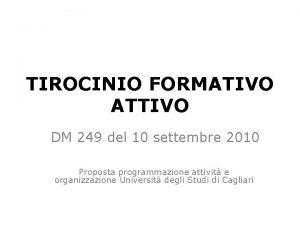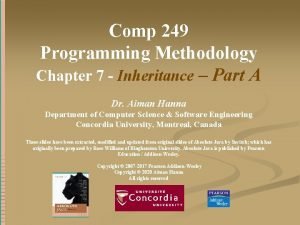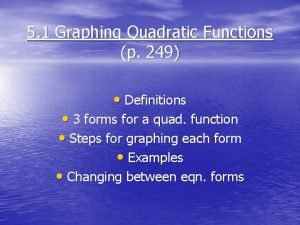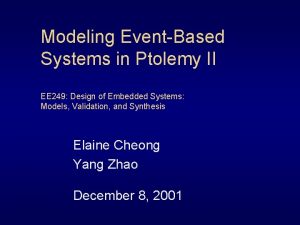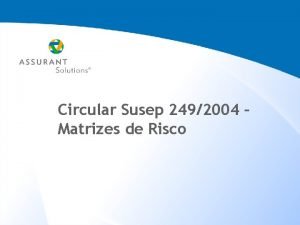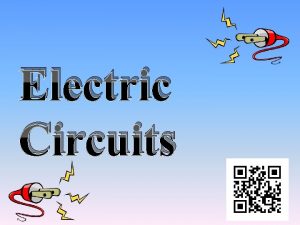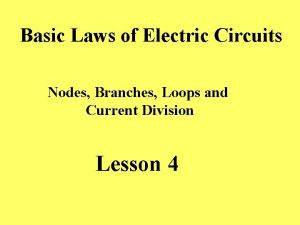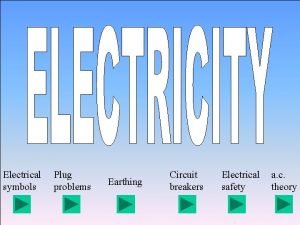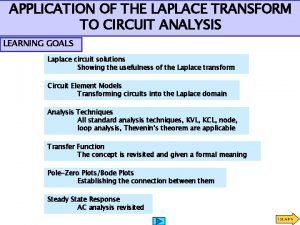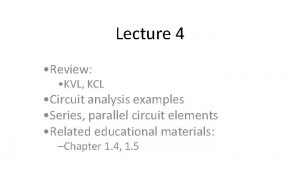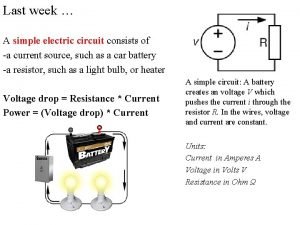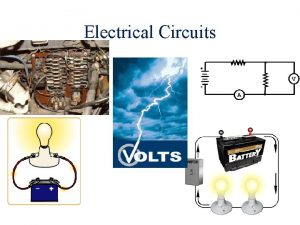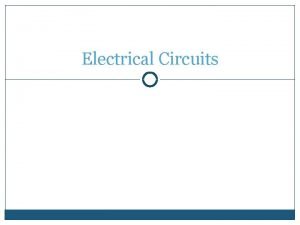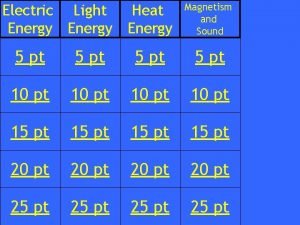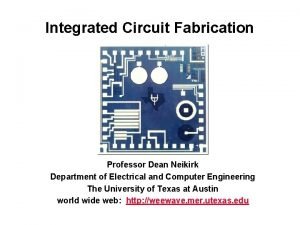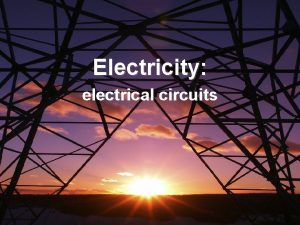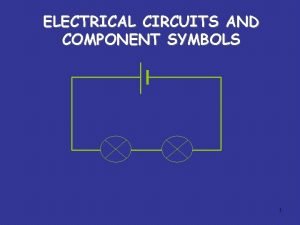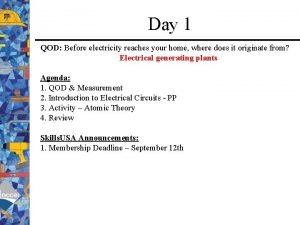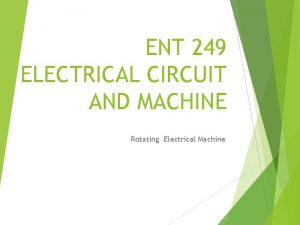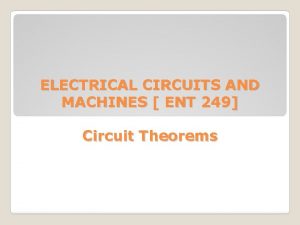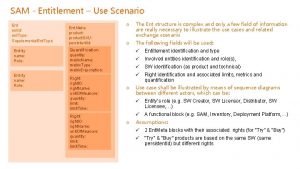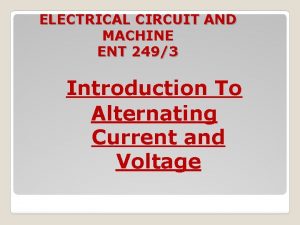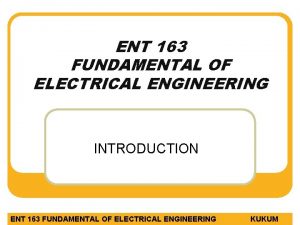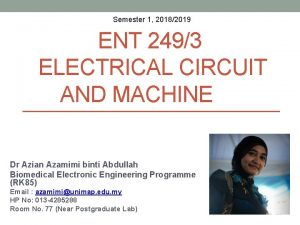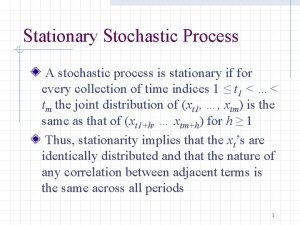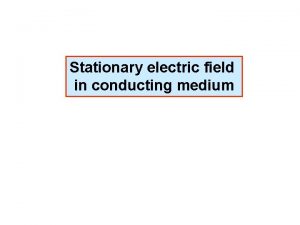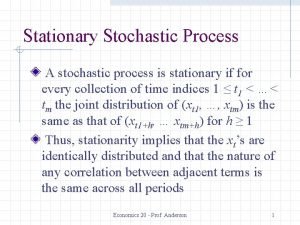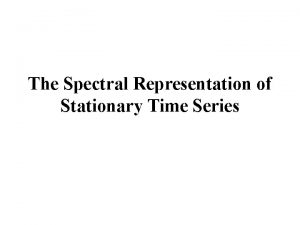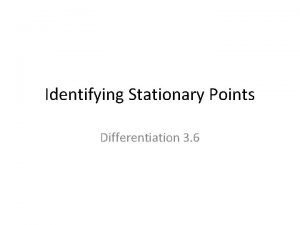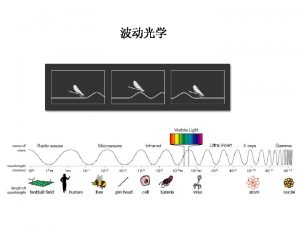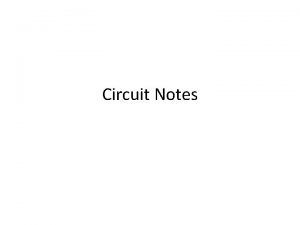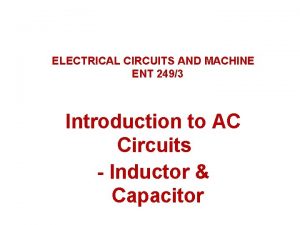ENT 249 ELECTRICAL CIRCUIT AND MACHINE STATIONARY MACHINE


































- Slides: 34

ENT 249 ELECTRICAL CIRCUIT AND MACHINE (STATIONARY MACHINE)

Introduction • All electrical machine operate on a common set of principles. • The most simple electrical machine involve with linear movement (e. g. relay and contactor). • Stationary machine (e. g. transformers, relay and contactor) • Rotating machine (e. g. motors)

Conversion Process In A Machine • An electromagnetic machine is one that links an electrical energy system to another energy system by providing a reversible mean of energy flow in its magnetic field. • The coupling between two system is called mutual link. • The energy transferred from one to another system is temporarily stored in the field.

Transformers • • • MUTUAL INDUCTANCE INTRODUCTION TO TRANSFORMER STEP-UP AND STEP-DOWN TRANSFORMER LOADING THE SECONDARY WINDING IDEAL TRANSFORMER

MUTUAL INDUCTANCE When a second coil is placed very close to the first coil so that the changing magnetic lines of force cut through the second coil, the coils are magnetically coupled and a voltage is induced. When two coils are magnetically coupled, they provide electrical isolation because there is no electrical connection between them, only magnetic link.

MUTUAL INDUCTANCE • The amount of voltage induced in the second coil as a result of the current in the first coil is dependent on the mutual inductance. • The mutual inductance is established by the inductance of each coil (L 1 and L 2) and by the amount of coupling k between the two coils. • Mutual inductance is the ability of one inductor to induce a voltage across a neighboring inductor, measured in Henrys (H). of Coupling Coefficient coupling (k) is depends on on the physical • To maximize coupling, the two coils are wound same closeness of the coils and the core. type of core material that they are wound. Also the construction and shape of the core. = the flux ( lines of force) produced by the primary linking of secondar =the total flux produced by the primary

MUTUAL INDUCTANCE Formula for Mutual Inductance �� Example 1

INTRODUCTION TO TRANSFORMER q A transformer is a stationary electric machine which transfers electrical energy (power) from one voltage level to another voltage level. q Unlike in rotating machines, there is no electrical to mechanical energy conversion.

INTRODUCTION TO TRANSFORMER The Basic ATransformer basic transformer is an electrical device constructed of two coils of wire (windings) magnetically coupled to each other so that there is a mutual inductance for the transfer of power from one winding to the other. A schematic of a transformer

INTRODUCTION TO TRANSFORMER • The source voltage is applied to the primary winding, and the load is connected to the secondary winding. • The primary winding is the input winding, and the secondary winding is the output winding. • There are three general categories of core material: air, ferrite, and iron. Schematic symbols based on type of core.

INTRODUCTION TO TRANSFORMER The amount of magnetic coupling between the primary winding and the secondary winding is set by the type of core material and by the relative positions of the windings. Transformers with cylindrical-shaped cores. Iron-core transformer construction with multilayer windings.

INTRODUCTION TO TRANSFORMER Some common types of transformers. Common type of small transformers Planar transformer Low-voltage transformer Turns Ratio Function of transformer – stepping up or stepping down ac voltage or currents

Example 2 A transformer primary winding has 100 turns, and the secondary winding has 400 turns. What is the turns ratio? Solution:

INTRODUCTION TO TRANSFORMER How does a transformer work? • • An AC current in the primary coil creates a changing magnetic field in the iron core. This changing magnetic field induces a current in the secondary coil as described by Faraday’s Law. Primary voltage Iron core

INTRODUCTION TO TRANSFORMER Direction of winding The direction of the windings determines the polarity of the voltage across the secondary winding (secondary voltage) with respect to the voltage across the primary winding (primary voltage). Phase dots indicate relative polarities of primary and secondary voltages.

STEP-UP AND STEP DOWN TRANSFORMERS What is a step-up transformer? • A transformer in which the secondary voltage is greater than the primary voltage. • The amount that the voltage is stepped up depends on the turns ratio.

STEP-UP AND STEP DOWN TRANSFORMERS Applications Power plants to increase the generated voltage and send it to high voltage transmission lines. To increase the voltage in order to get higher electrical field (TVs, Radar and Microwaves, …)

Example 3 The transformer in Figure has a turns ratio of 3. What is the voltage across the secondary winding? Solution: Note that the turns ratio of 3 is indicated on the schematic as 1: 3. meaning that there are three secondary turns for each primary turn.

STEP-UP AND STEP DOWN TRANSFORMERS What is a step-down transformer? • A transformer in which the secondary voltage is less than the primary voltage. • The amount by which the voltage is stepped down depends on the turns ratio.

STEP-UP AND STEP DOWN TRANSFORMERS Applications Electrical distribution networks (to reduce the voltage from medium voltage (10, 000 V – 30 000 V) to low voltage (110 V – 208 V) for different customers). Distribution Transformers used by Hydro companies to deliver the electric ener

STEP-UP AND STEP DOWN TRANSFORMERS Application s To reduce plug voltage (110 V) to lower voltages in electronic. Equipments/ circuits such as radio, phone, laptop, adaptors, …

Example 4 The transformer in Figure has a turns ratio of 0. 2, What is the secondary voltage? Solution:

LOADING THE SECONDARY WINDING When a resistive load is connected to the secondary winding of a transformer, the relationship of the load (secondary) current and the current in the primary circuit is determined by the turns ratio. • Thus, for a step-up transformer, in which n is greater than 1, the secondary current is less than the primary current. • For a step-down transformer, n is less than 1, and Isec is greater than Ipri • When the secondary voltage is greater than the primary voltage, the secondary current is lower than the primary current and vice versa.

Example 5 The two transformers in Figure have loaded secondary windings. If the primary current is 100 m. A in each case. what is the load current? SOLUTION

IDEAL TRANSFORMER • Ideal transformer is one with perfect coupling (k=1). • Ideal transformer is a unity-coupled, lossless transformer in which the primary and secondary coils have infinite self – inductances. • Iron core transformers are close approximation to ideal transformer. • These are used in power systems and electronics. Ideal Transformer Circuit Symbol for Ideal Transformers

IDEAL TRANSFORMER Relating primary and secondary quantities in an ideal transformer. The turns ratio or transformation ratio:

Example 5 1. A transformer primary winding has 100 turns, and the secondary winding has winding 400 turns. What is the turns ratio? 2. A certain transformer has a turn ratio of 10. If Npri = 500, what is Nsec?

Example 5 1. A transformer primary winding has 100 turns, and the secondary winding has winding 400 turns. What is the turns ratio? n = Nsec / Npri = 400/100 = 4 2. A certain transformer has a turn ratio of 10. If Npri = 500, what is Nsec? n = 10, Npri = 500 Nsec = n X Npri = 10 X 500 = 5000

Reflected Impedance and Power Ø From previous, know that Ø The input impedance of the circuit connected to a source is Ø ……………. . ………eq (1) Ø The transformer is represented by the equation …………eq (2) Where n=N 2/N 1 is equal to turns ratio of the transformer

Reflected Impedance and Power Ø The current and voltage of the impedance I 2 and V 2, do not adhere to the passive convention so, …………eq (3) Ø Therefore the input impedance ,

IDEAL TRANSFORMER q For an ideal transformer , the complex power (VA) in the primary winding is equal to the secondary: P 1 = V 1 I 1 = V 2 I 2 = P 2 where, P 1= power in the primary winding P 2=power in secondary winding (This shows that the complex power supplied to the primary is delivered to the secondary without loss, since ideal transformer is lossless).

Impedance Matching Transformer q Transformers can be particularly useful when you are trying to ensure that a load receives maximum power from a source. q Recall that the maximum power transferred to a load when it impedance is a match with internal resistance of a supply. q The closer load matches the internal resistance, the greater power transfer to the load and the more efficient is the system. q Transformers have a unique relationship between their primary and secondary impedances that can be put to good use in the impedance matching process.

Impedance Matching Transformer q Example: a. The source impedance for the supply in Figure 8(a) is 500 Ω which is a poor match with 8 Ω input impedance of the speaker. You can expect only that the power delivered to the speaker will be significantly less than the maximum possible level. Determine the power to the speaker under this condition. b. In figure 8(b), a commercially available 500 Ω to 8 Ω audio impedance matching transformer was introduced between the speaker and the source. Determine the input impedance of the transformer and the power delivered to the speaker. c. Find the approximate turns ratio for the transformer.

Further reading… 1. Principles of Electric Circuits; Conventional Current version, 8 th Edition, Pearson, Floyd. 2. Fundamental of Electric Circuits. 2 nd Edition, Mc. Graw. Hill, Alexander & Sadiku. 3. Electrical Machines, Drives, And Power System, 6 th Edition, Pearson Prientice Hall, Wildi.
 Lesson 5: electrical nonmetallic tubing (ent)
Lesson 5: electrical nonmetallic tubing (ent) Dm 249 2010
Dm 249 2010 Artigo 249 cc
Artigo 249 cc Contoh cek tak laku
Contoh cek tak laku Comp 249
Comp 249 How to convert y=a(x-h)^2+k into y=ax2+bx+c
How to convert y=a(x-h)^2+k into y=ax2+bx+c V c c
V c c Ee 249
Ee 249 2492004
2492004 Fusao
Fusao What is incomplete circuit
What is incomplete circuit Series and parallel circuits similarities
Series and parallel circuits similarities Blood circulation system diagram
Blood circulation system diagram Politeknik kota bharu
Politeknik kota bharu Basic laws
Basic laws Live neutral earth symbols
Live neutral earth symbols Laplace domain circuit analysis
Laplace domain circuit analysis Circuit analysis examples
Circuit analysis examples Simple electric circuit with label
Simple electric circuit with label What is an electrical load
What is an electrical load Flashlight electrical circuit
Flashlight electrical circuit Electrical circuit
Electrical circuit Capacitor laplace
Capacitor laplace What three elements are required for all electric circuits
What three elements are required for all electric circuits Dean neikirk
Dean neikirk Rope loop model electricity
Rope loop model electricity Draw a simple circuit and label the parts
Draw a simple circuit and label the parts An electrical circuit contains at minimum a
An electrical circuit contains at minimum a V
V Types of circuit
Types of circuit Parallel circuit circuit construction kit
Parallel circuit circuit construction kit Current in series
Current in series Short circuit example
Short circuit example Advantages of parallel circuit over series circuit
Advantages of parallel circuit over series circuit Difference between hauled and stationary container system
Difference between hauled and stationary container system

